Designing a Novel THz Band 2-D Wide-Angle Scanning Phased-Array Antenna Based on a Decoupling Surface
Abstract
:1. Introduction
2. The Design of the Element
2.1. Element Configuration
2.2. The Simulated Results
2.3. Parameters and Coupling Analysis
3. The Performance of the 8 × 8 PAA
3.1. The PAA Configuration
3.2. The Simulated Scanning Performance
4. Discussion
5. Conclusions
Author Contributions
Funding
Institutional Review Board Statement
Informed Consent Statement
Data Availability Statement
Conflicts of Interest
References
- Rappaport, T.S.; Xing, Y.; Kanhere, O.; Ju, S.; Madanayake, A.; Mandal, S.; Alkhateeb, A.; Trichopoulos, G.C. Wireless Communications and Applications above 100 GHz: Opportunities and Challenges for 6G and Beyond. IEEE Access. 2019, 7, 78729–78757. [Google Scholar] [CrossRef]
- Zhang, J.; Kang, K.; Huang, Y.; Shafi, M.; Molisch, A.F. Millimeter and THz Wave for 5G and Beyond. China Commun. 2019, 16, iii–vi. [Google Scholar]
- Okada, K. Sub-THz CMOS Phased-Array Transceiver Design for 6G. In Proceedings of the 2024 IEEE International Symposium on Circuits and Systems (ISCAS), Singapore, 19–22 May 2024; pp. 1–4. [Google Scholar]
- Okada, K. Millimeter-Wave/THz CMOS Phased-Array Transceiver for 5G and Beyond. In Proceedings of the 2022 IEEE International Symposium on Radio-Frequency Integration Technology (RFIT), Busan, Republic of Korea, 29–31 August 2022; pp. 219–221. [Google Scholar]
- Okada, K. CMOS THz Phased-Array Transceivers for beyond 5G. In Proceedings of the 2021 IEEE International Symposium on Radio-Frequency Integration Technology (RFIT), Hualien, Taiwan, 25–27 August 2021; pp. 1–2. [Google Scholar]
- Jiang, M.; Chen, Z.N.; Zhang, Y.; Hong, W.; Xuan, X. Metamaterial-Based Thin Planar Lens Antenna for Spatial Beamforming and Multibeam Massive MIMO. IEEE Trans. Antennas Propag. 2017, 65, 464–472. [Google Scholar] [CrossRef]
- Plaza, E.G.; Costa, J.R.; Fernandes, C.A.; León, G.; Loredo, S.; Las-Heras, F. A Multibeam Antenna for Imaging Based on Planar Lenses. In Proceedings of the 2015 9th European Conference on Antennas and Propagation (EuCAP), Lisbon, Portugal, 13–17 April 2015; pp. 1–5. [Google Scholar]
- Tsai, Z.-C.; Chou, H.-T. Waveguide-Type Transmitarray Antennas with a Concave Surface Profile Analogous to Rotman Lens for Spatial Feeding to Radiate Collinear Multi-Beams. In Proceedings of the 2017 International Symposium on Antennas and Propagation (ISAP), Phuket, Thailand, 30 October–2 November 2017; pp. 1–2. [Google Scholar]
- Beccaria, M.; Massaccesi, A.; Pirinoli, P.; Manh, L.H. Multibeam Transmitarrays for 5G Antenna Systems. In Proceedings of the 2018 IEEE Seventh International Conference on Communications and Electronics (ICCE), Hue, Vietnam, 18–20 July 2018; pp. 217–221. [Google Scholar]
- Nayeri, P.; Yang, F.; Elsherbeni, A.Z. Bifocal Design and Aperture Phase Optimizations of Reflectarray Antennas for Wide-Angle Beam Scanning Performance. IEEE Trans. Antennas Propag. 2013, 61, 4588–4597. [Google Scholar] [CrossRef]
- Cui, Y.; Bahr, R.; Nauroze, S.A.; Cheng, T.; Almoneef, T.S.; Tentzeris, M.M. 3D Printed “Kirigami”-Inspired Deployable Bi-Focal Beam-Scanning Dielectric Reflectarray Antenna for Mm-Wave Applications. IEEE Trans. Antennas Propag. 2022, 70, 7683–7690. [Google Scholar] [CrossRef]
- Yang, G.; Zhang, S. Dual-Polarized Wide-Angle Scanning Phased Array Antenna for 5G Communication Systems. IEEE Trans. Antennas Propag. 2022, 70, 7427–7438. [Google Scholar] [CrossRef]
- Jalili, H.; Momeni, O. Scalable Wideband and Wide-Angle Beam Steering Mm-Wave/THz Radiator and Phased Arrays in Silicon. In Proceedings of the 2018 Asia-Pacific Microwave Conference (APMC), Kyoto, Japan, 6–9 November 2018; pp. 1157–1159. [Google Scholar]
- Tousi, Y.; Afshari, E. A Scalable THz 2D Phased Array with +17dBm of EIRP at 338GHz in 65nm Bulk CMOS. In Proceedings of the 2014 IEEE International Solid-State Circuits Conference Digest of Technical Papers (ISSCC), San Francisco, CA, USA, 9–13 February 2014; pp. 258–259. [Google Scholar]
- Valdes-Garcia, A.; Floyd, B.; Nicolson, S.T.; Lai, J.-W.; Natarajan, A.; Chen, P.-Y.; Reynolds, S.K.; Zhan, J.-H.C.; Kam, D.G.; Liu, D. A Fully Integrated 16-Element Phased-Array Transmitter in SiGe BiCMOS for 60-GHz Communications. IEEE J. Solid-State Circuits 2010, 45, 2757–2773. [Google Scholar] [CrossRef]
- Fu, X.; Yang, F.; Liu, C.; Wu, X.; Cui, T.J. Terahertz Beam Steering Technologies: From Phased Arrays to Field-programmable Metasurfaces. Adv. Opt. Mater. 2020, 8, 1900628. [Google Scholar] [CrossRef]
- Mangiavillano, C.; Zachl, G.; Hüttner, R.; Wagner, T.; Stelzer, A.; Pretl, H. A 0.32-THz 4-Transmitter Phased Array Using Chiplets in 130-Nm SiGe BiCMOS. In Proceedings of the 2023 Asia-Pacific Microwave Conference (APMC), Taipei, Taiwan, 5–8 December 2023; pp. 757–759. [Google Scholar]
- Yang, L.-Y.O.; Wu, W.-H.; Tsai, B. EIRP Optimization of a Phased Array with Mutual Coupling for THz Applications. In Proceedings of the 2022 IEEE Conference on Antenna Measurements and Applications (CAMA), Guangzhou, China, 14–17 December 2022; pp. 1–3. [Google Scholar]
- Prather, D.W.; Murakowski, J.A.; Schuetz, C.; Shi, S.; Schneider, G.J.; Harrity, C.; Aranda, Z.D.; Marinucci, D.; Hallak, A.; Zablocki, M.; et al. Millimeter-Wave and Sub-THz Phased-Array Imaging Systems Based on Electro-Optic up-Conversion and Optical Beamforming. IEEE J. Select. Top. Quantum Electron. 2023, 29, 8501014. [Google Scholar] [CrossRef]
- Li, P.; Shi, Y.; Deng, Y.; Liu, L. Computational Analysis of a 200 GHz Phased Array Using Lens-Coupled Annular-Slot Antennas. Appl. Sci. 2022, 12, 1407. [Google Scholar] [CrossRef]
- Guo, K.; Reynaert, P. A 0.59THz Beam-Steerable Coherent Radiator Array with 1mW Radiated Power and 24.1dBm EIRP in 40nm CMOS. In Proceedings of the 2020 IEEE International Solid- State Circuits Conference—(ISSCC), San Francisco, CA, USA, 16–20 February 2020; pp. 442–444. [Google Scholar]
- Saeidi, H.; Venkatesh, S.; Chappidi, C.R.; Sharma, T.; Zhu, C.; Sengupta, K. A 4×4 Distributed Multi-Layer Oscillator Network for Harmonic Injection and THz Beamforming with 14dBm EIRP at 416GHz in a Lensless 65nm CMOS IC. In Proceedings of the 2020 IEEE International Solid- State Circuits Conference—(ISSCC), San Francisco, CA, USA, 16–20 February 2020; pp. 256–258. [Google Scholar]
- Gao, L.; Chan, C.H. A 0.64-to-0.69THz Beam-Steerable Coherent Source with 9.1dBm Radiated Power and 30.8dBm Lensless EIRP in 65nm CMOS. In Proceedings of the 2023 IEEE International Solid- State Circuits Conference (ISSCC), San Francisco, CA, USA, 19–23 February 2023; pp. 362–364. [Google Scholar]
- Wu, K.-L.; Wei, C.; Mei, X.; Zhang, Z.-Y. Array-Antenna Decoupling Surface. IEEE Trans. Antennas Propag. 2017, 65, 6728–6738. [Google Scholar] [CrossRef]
- Lin, L.-X.; Tu, Z.-H.; Zhu, H. Isolation Enhancement in Millimeter-Wave MIMO Array Base on Array-Antenna Decoupling Surface. In Proceedings of the 2022 IEEE MTT-S International Microwave Workshop Series on Advanced Materials and Processes for RF and THz Applications (IMWS-AMP), Guangzhou, China, 13–15 November 2022; pp. 1–3. [Google Scholar]
- Wang, Z.; Tu, Z.-H.; Yuan, Z.; Chen, F.-C. Decoupling and Wide-Angle Scanning Design of a Millimeter-Wave Phased Array Using Square-Ring Metasurface. IEEE Antennas Wirel. Propag. Lett. 2023, 22, 1828–1832. [Google Scholar] [CrossRef]
- Li, D.F.; Zhong, Y.C.; Liu, Y. Planar Low-Profile 2-D Wide-Angle Scanning Phased Array in X-Band Based on SIW. In Proceedings of the 2022 IEEE 10th Asia-Pacific Conference on Antennas and Propagation (APCAP), Xiamen, China, 4–7 November 2022; pp. 1–2. [Google Scholar]
- Wang, Z.; Hu, Y.; Xiang, L.; Xu, J.; Hong, W. A Wideband High-Gain Planar Monopulse Array Antenna for Ka-Band Radar Applications. IEEE Trans. Antennas Propag. 2023, 71, 8739–8752. [Google Scholar] [CrossRef]
- Puskely, J.; Mikulasek, T.; Aslan, Y.; Roederer, A.; Yarovoy, A. 5G SIW-Based Phased Antenna Array with Cosecant-Squared Shaped Pattern. IEEE Trans. Antennas Propag. 2022, 70, 250–259. [Google Scholar] [CrossRef]
- Ding, Y.R.; Cheng, Y.J.; Sun, J.X.; Wang, L.; Li, T.J. Dual-Band Shared-Aperture Two-Dimensional Phased Array Antenna with Wide Bandwidth of 25.0% and 11.4% at Ku- and Ka-Band. IEEE Trans. Antennas Propag. 2022, 70, 7468–7477. [Google Scholar] [CrossRef]
- Song, A.H.; Cheng, Y.J. Shared-Aperture Dual-Polarized Ku-Band and Single-Polarized Ka-Band Phased Array Antenna with Scanning Coverage Enhancement. IEEE Trans. Antennas Propag. 2022, 70, 10426–10435. [Google Scholar] [CrossRef]
- Lu, S.; Qu, S.-W.; Li, P.-F. Low-Profile Ku-/Ka-Band Shared-Aperture Phased Array. IEEE Trans. Antennas Propag. 2024, 72, 300–309. [Google Scholar] [CrossRef]
- Jiang, W.; Liao, S.; Che, W.; Xue, Q. Millimeter-Wave Wideband ±45° Dual-Polarized Phased Array Antenna Based on Compact Wideband Widebeam Dipole Element Antenna. IEEE Antennas Wirel. Propag. Lett. 2023, 22, 1813–1817. [Google Scholar] [CrossRef]
- Tang, Z.; Dong, Y. A Ka-Band Antenna Array Based on Wide-Beamwidth Magnetoelectric Dipole. IEEE Antennas Wirel. Propag. Lett. 2022, 21, 501–505. [Google Scholar] [CrossRef]
- Yang, G.; Li, J.; Wei, D.; Xu, R. Study on Wide-Angle Scanning Linear Phased Array Antenna. IEEE Trans. Antennas Propag. 2018, 66, 450–455. [Google Scholar] [CrossRef]
- Gu, L.; Liao, S.; Che, W. Novel Coupling Cancellation Method by Loading Planar Path for Wideband High-Isolation Wide-Scanning Millimeter-Wave Phased Array. IEEE Trans. Antennas Propag. 2022, 70, 10520–10530. [Google Scholar] [CrossRef]
- Li, J.; Zhu, Y.; Hu, Y.; Hong, W. A Miniaturized Dual-Polarized Active Phased Array Antenna for 5G Millimeter-Wave Applications. IEEE Antennas Wirel. Propag. Lett. 2024, 23, 618–622. [Google Scholar] [CrossRef]
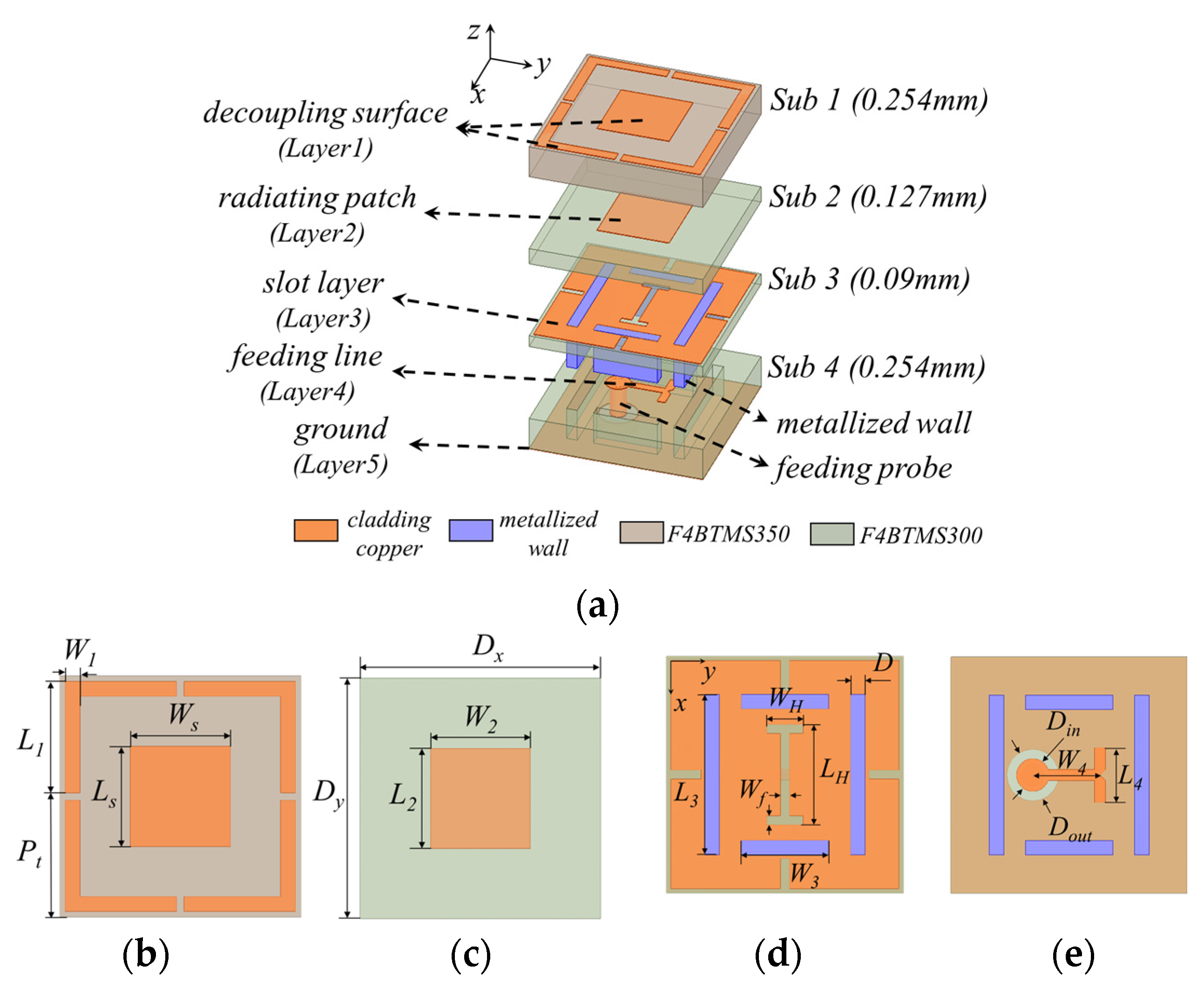
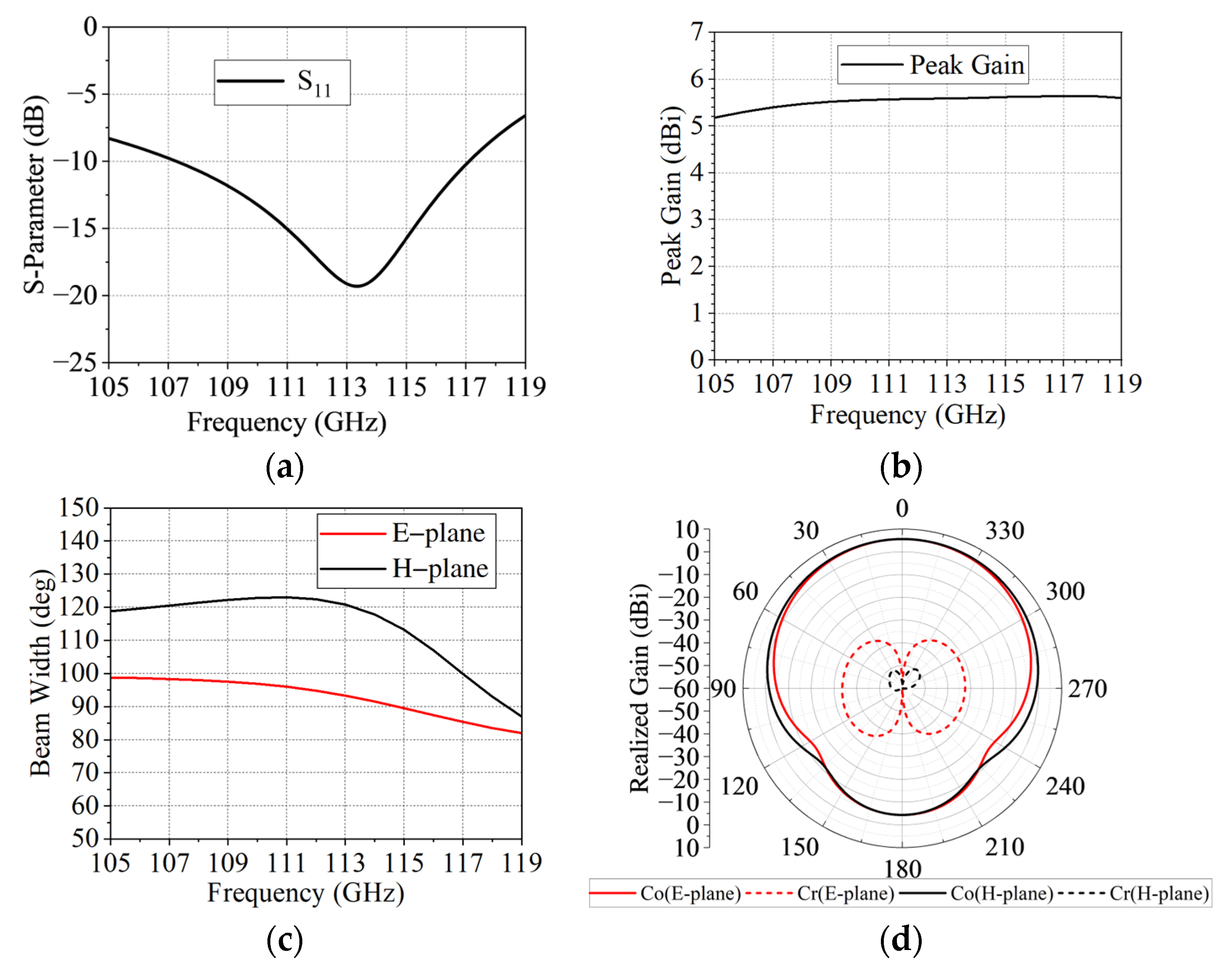

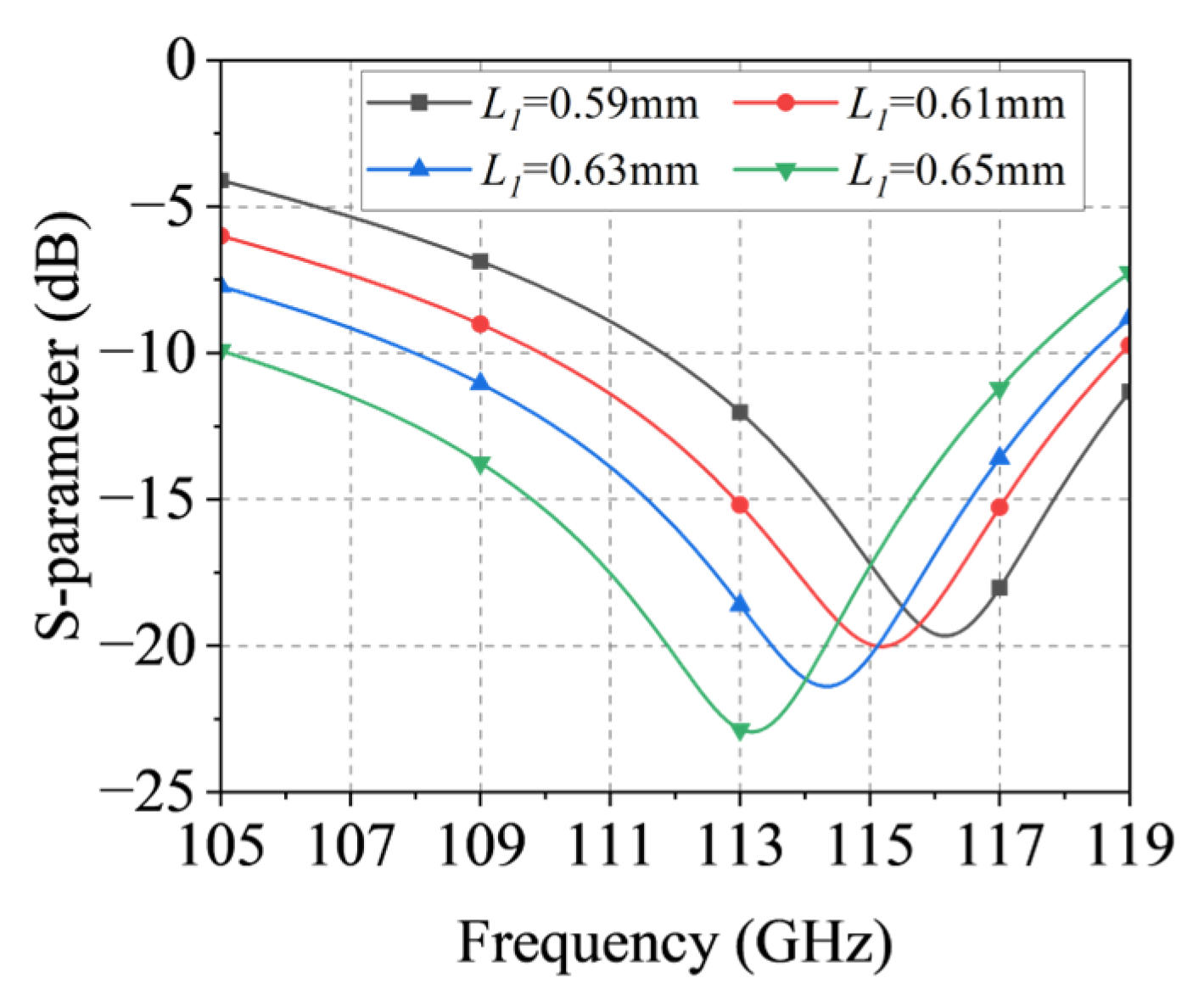
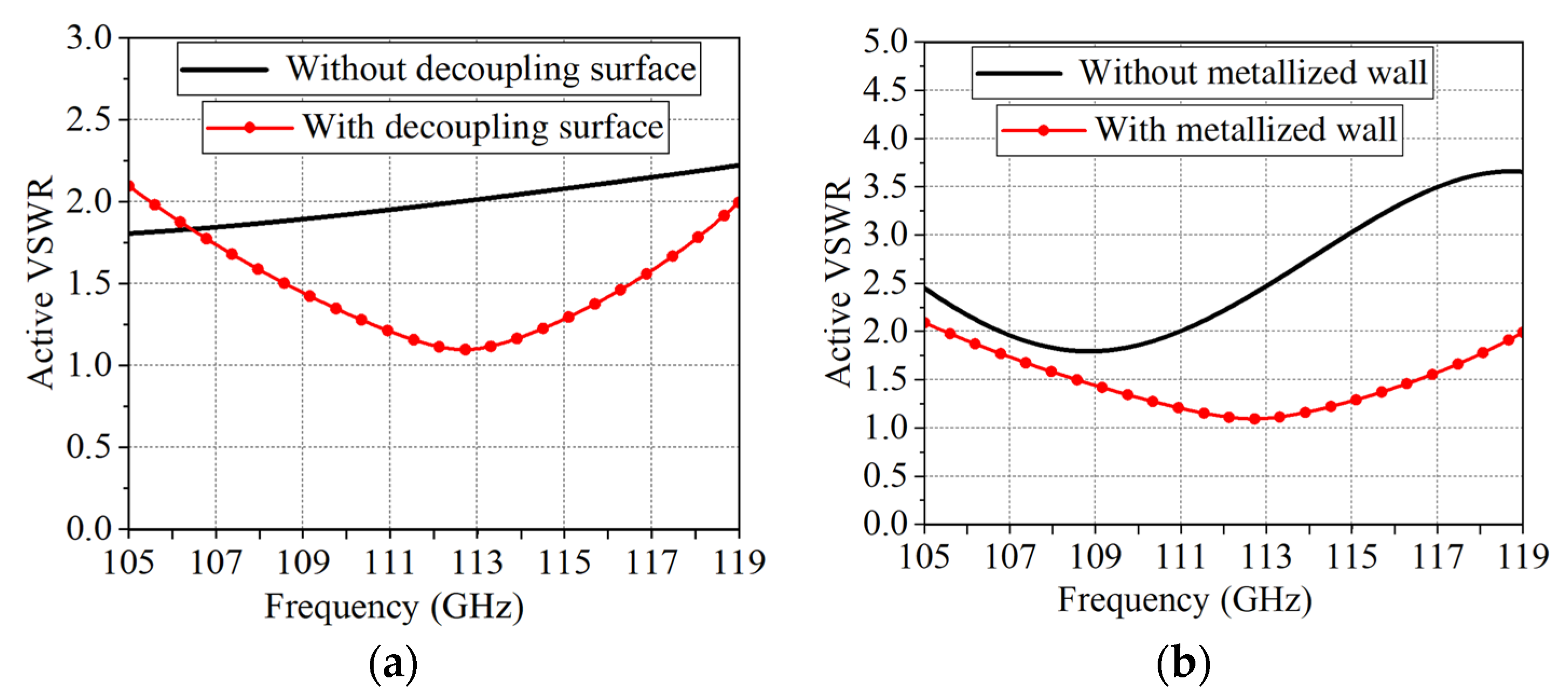



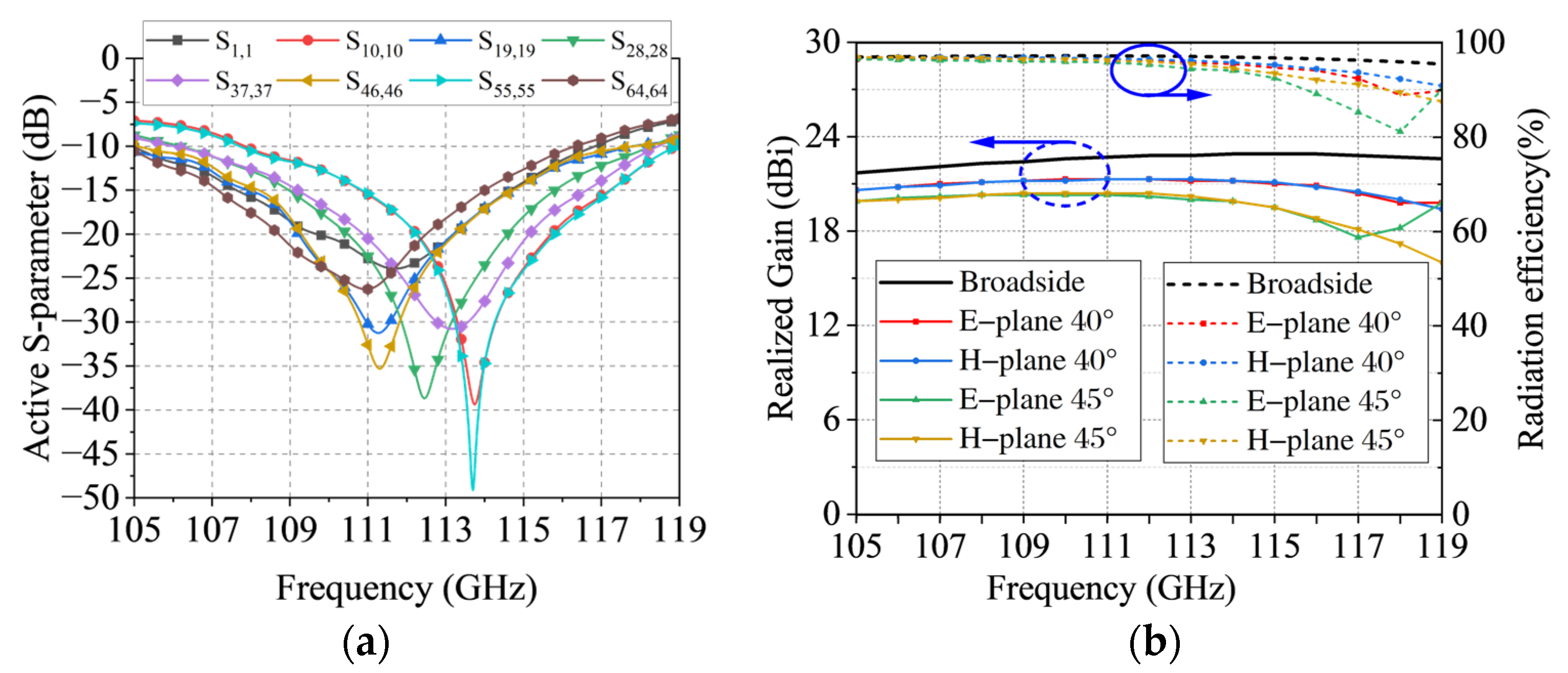
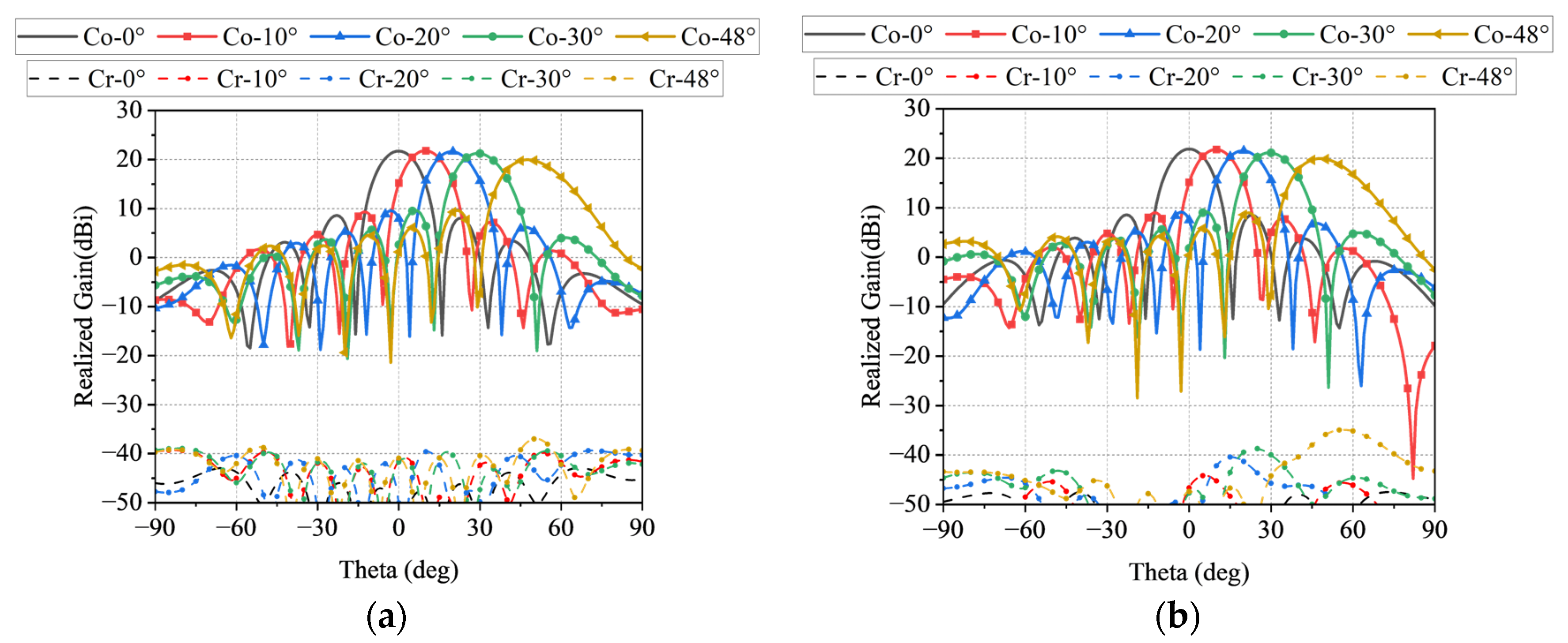
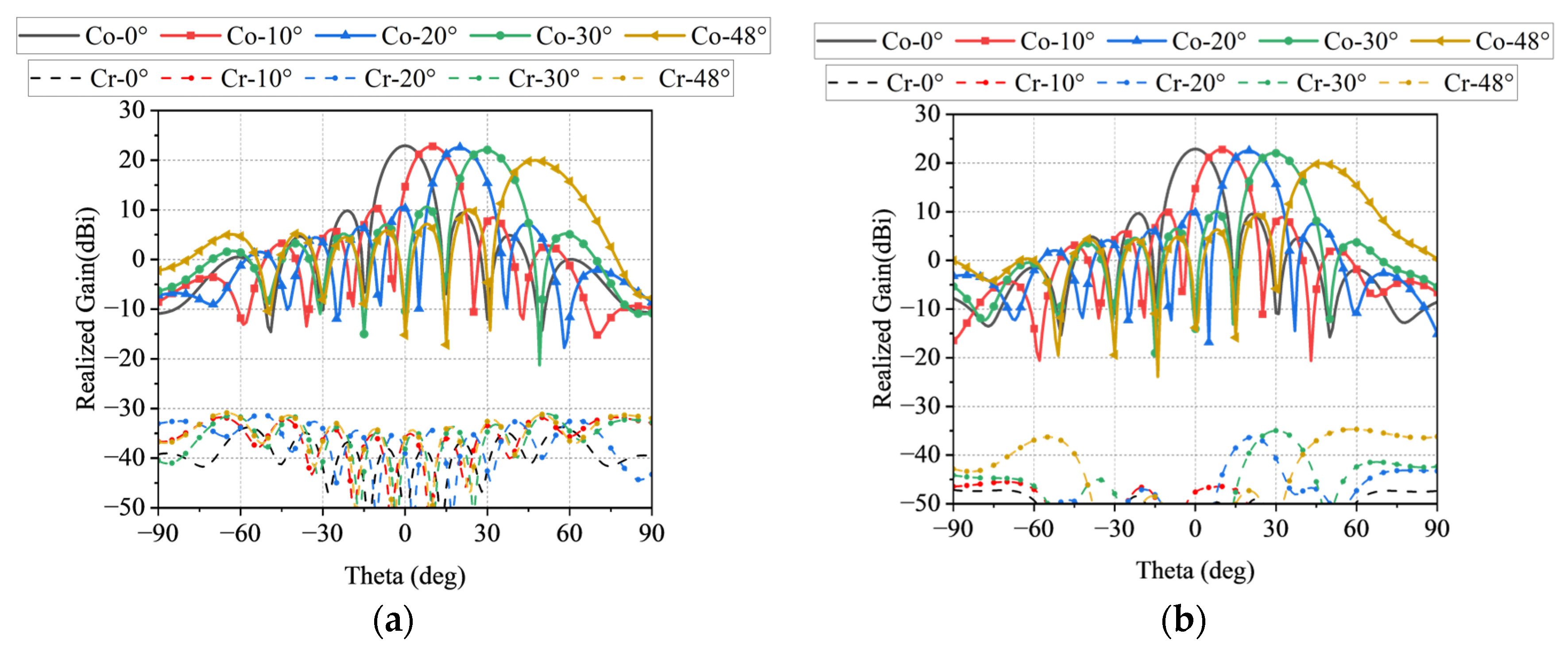

| Parameter | Value | Parameter | Value |
|---|---|---|---|
| L1 | 0.65 | W1 | 0.08 |
| L2 | 0.54 | W2 | 0.54 |
| L3 | 0.88 | W3 | 0.48 |
| L4 | 0.30 | W4 | 0.37 |
| Ls | 0.52 | Ws | 0.52 |
| LH | 0.55 | WH | 0.20 |
| Dx | 1.30 | Dy | 1.30 |
| Din | 0.18 | Dout | 0.29 |
| Pt | 0.72 | Wf | 0.05 |
| Reference | Frequency (GHz) | Array Size | Scanning Dimension | Beam Scanning (°) | Fabrication Technology |
|---|---|---|---|---|---|
| [20] | 200 | 1 × 5 | 1-D | 62 | N/A |
| [21] | 586.7 | 6 × 6 | 1-D | 30 | 40 nm CMOS |
| [22] | 416 | 4 × 4 | 2-D | 60/60 | 65 nm CMOS |
| [23] | 675 | 12 × 12 | 1-D | 90 | 65 nm CMOS |
| This work | 106 | 8 × 8 | 2-D | 96/96 | N/A |
| 114 | 96/96 | ||||
| 119 | 80/80 |
Disclaimer/Publisher’s Note: The statements, opinions and data contained in all publications are solely those of the individual author(s) and contributor(s) and not of MDPI and/or the editor(s). MDPI and/or the editor(s) disclaim responsibility for any injury to people or property resulting from any ideas, methods, instructions or products referred to in the content. |
© 2024 by the authors. Licensee MDPI, Basel, Switzerland. This article is an open access article distributed under the terms and conditions of the Creative Commons Attribution (CC BY) license (https://creativecommons.org/licenses/by/4.0/).
Share and Cite
Xiong, B.; Xie, W.; Zhu, Y. Designing a Novel THz Band 2-D Wide-Angle Scanning Phased-Array Antenna Based on a Decoupling Surface. Appl. Sci. 2024, 14, 8618. https://doi.org/10.3390/app14198618
Xiong B, Xie W, Zhu Y. Designing a Novel THz Band 2-D Wide-Angle Scanning Phased-Array Antenna Based on a Decoupling Surface. Applied Sciences. 2024; 14(19):8618. https://doi.org/10.3390/app14198618
Chicago/Turabian StyleXiong, Bao, Wenxuan Xie, and Yongzhong Zhu. 2024. "Designing a Novel THz Band 2-D Wide-Angle Scanning Phased-Array Antenna Based on a Decoupling Surface" Applied Sciences 14, no. 19: 8618. https://doi.org/10.3390/app14198618





